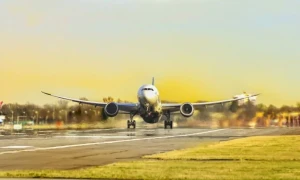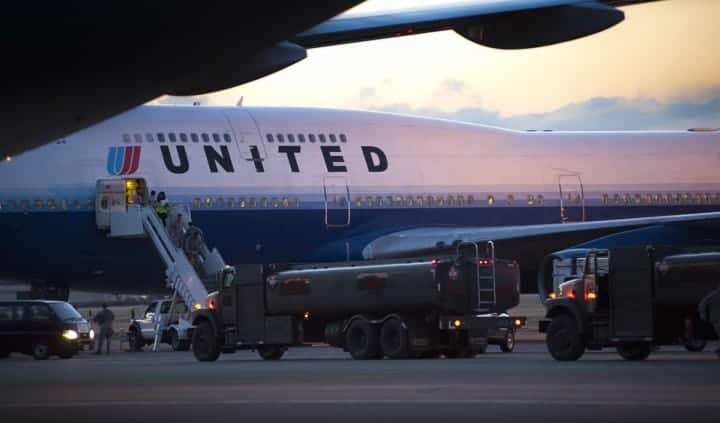How much does an airplane weigh?
An average airplane weighs around 90,000 pounds (41,000 kilos) empty weight, which means the weight of the airplane when its fuel tanks are empty and there are no people or luggage on board. This example is for a B-737-800 aircraft (which I flew all over the world, see my story here) which is considered a medium-sized commercial jet airliner.

You can expect to add 84,000 pounds (38,000 kilos) of fuel, passengers, and baggage to that number to get a maximum takeoff weight of 174,000lbs (79,000 kilos)
Obviously, these numbers depend dramatically on the type of aircraft you are referring to. I will show you 13 examples of different airplane weights in this article for you to reference. As a general rule, you can expect most airliners to weigh about 1350 pounds per foot length! (I know it’s an odd stat but I thought you would find that interesting). Again using the 737-800 as an example.
Related: Do You Need A Gold Star On Your Driver’s License Or ID To Fly?
Here are a few examples of common aircraft and how much they weigh
- Cessna 172 – Used by many as initial training aircraft (27 feet long) – 1450lbs empty weight, 2450lbs max weight
- Citation Jet M2 – (42 feet long) – 6990lbs empty weight, 10,700lbs max weight
- Boeing 767-300 – (185 feet long) – 195,000lbs empty weight, 400,000 max weight
- Boeing 787-800 – (186 feet long) – 264,500lbs empty weight, 502,500lbs max weight
- Boeing 777-300 – (242 feet long) – 354,000lbs empty weight, 660,000lbs max weight
- Boeing 747-400 – (232 feet long) – 407,000lbs empty weight, 910,000lbs max weight
- Airbus A320 – (123 feet long) – 82,000lbs empty weight, 170,000lbs max weight
- Airbus A330 – (210 feet long) – 274,500lbs empty weight, 507,000lbs max weight
What is the world’s largest plane?
The world’s largest passenger airliner is the Airbus A380. Its maximum takeoff weight is over a million pounds!

Airbus A380 – (240 feet long) – 610,700lbs empty weight, 1,234,600lbs max weight
What is the heaviest plane?
The Antonov An-225 Mriya is the largest aircraft. It is the longest plane, and with six engines is both the heaviest aircraft ever built and the largest wingspan of an aircraft.
Fuel And Passenger Weights

Fuel and passenger weights play a crucial role in determining the maximum weight of the aircraft. Every aircraft has a maximum weight that is provided by the manufacturer. This number is not to be exceeded for any aircraft used privately or commercially.
In order to determine the actual weight of the aircraft, you must add the empty weight of the plane + fuel weight + passenger weight + baggage weight. This number cannot be above the maximum allowable weight limit of the aircraft.
Aircraft fuel can be divided into 2 groups (for the purpose of this article). Avgas and Jet fuel. They both have different weights. Avgas is what the smaller non-jet engine aircraft will use. It weighs around 6lbs per U.S gallon. Jet fuel weighs slightly more at just under 7lbs per U.S gallon.
Passenger weights are determined by the actual weight of people on board. In the example of commercial airliners, there is no way to know the actual person weight of each person on board, so they use an average weight which is based on gender, age, time of year and also allows for carry on baggage they may be bringing.
Related: Can You Bring A Gillette Razor On A Plane?
How to calculate actual aircraft weight
It can be really confusing when looking at the numbers to determine the actual aircraft weight and what it all means. There are a few different terms you need to know.
OEW or Operating Empty Weight or Basic empty weight
OEW is is the weight of the aircraft as it sits empty without fuel, passengers or luggage. But it does include all necessary fluids for operation. (oil, coolant, water, hydraulic fluid, etc)
MTOW or Maximum takeoff weight
MTOW is the maximum weight of the aircraft to safely takeoff considering structural or other limits.
As mentioned, the maximum weight that any aircraft can be at the time of takeoff is MTOW.
This is calculated by taking OEW + Fuel + Passengers + Luggage – Fuel for taxi to runway = MTOW
Using our initial example of the B737-800 aircraft, the MTOW is 174,000 lbs.
To calculate the actual weight of the plane on the day of the flight, using our formula above: 90,000lbs + 60,000lbs fuel + 25,000 passengers + 1200lbs luggage – 100lbs fuel = 176,100 MTOW
NOTE: These numbers are just used as an example.
With so many variables involved, each aircraft is different and therefore will have different weights. Each aircraft will have its own OEW and depending on the payload, will have a different MTOW.
What does an average aircraft weigh?
The average medium-sized airliner weighs around 90,000lbs.
What is “minimum flight weight?”
Minimum flight weight refers to the minimum weight of a plane in its ready-to-fly status (meaning it has enough fuel in the fuel tank to make a realistic flight, other fluids like hydraulic and engine oils, and other miscellaneous items. Minimum flight weight doesn’t include flight crew or any cargo.
How much does a small plane weigh?
A small plane or aircraft as defined by 14 CFR part 1 is 12,500 lbs or less maximum certificated take-off weight.
Do planes have a weight limit for passengers?
No, there isn’t a weight limit for passengers in the United States on commercial flights, but some airlines do require customers who don’t easily fit in one seat to pay for an additional seat. If you have specific questions like this it is best to call the airline you are considering flying with to ask them about their passenger size regulations.
How much does it cost to fuel a 747?
A 747 can hold 63,000 gallons of jet fuel costing about $190,000 – $210,000.
How many people can a 747 seat?
A 747 can seat 370 to 550 people, depending on how the airline decides to configure its seats.
Is Boeing 777 bigger than 747?
No, a 747 can seat between 30 and 80 more people than a 777. The 777 is the next largest plane after the 747.
Hopefully, you enjoyed this article. As always, feel free to leave a comment and let us know your thoughts.
Thanks for reading!
You may also like:

